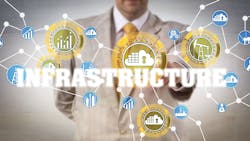Infrastructure on the Agenda
President Biden’s proposed $2 trillion infrastructure bill will be formally introduced in Pennsylvania on Wed., March 31, but details of the legislation already have been reported. The spending and tax package is a long way from approval in a deeply-divided Congress, but a proposal that includes federal money for roads, schools and healthcare and also generates jobs likely will have more bipartisan support than your average piece of legislation these days.
More importantly, the bill has a specific focus on several areas where engineers and manufacturers will be affected, both in terms of increased design and manufacturing and in terms of how they can do their jobs more efficiently. A few early areas of interest:
Manufacturing. The bill calls for $300 billion in manufacturing incentives, including for areas focused on clean and renewable energy. About $30 billion is targeted toward medical manufacturing and another $20 billion will create regional innovation centers to help communities develop local projects.
Another $50 billion is targeted toward semiconductor manufacturing, which could lead to larger-scale manufacturing in an age where electric vehicles are becoming a larger focus. And that ties into…
Transportation. The largest single area of the infrastructure bill is focused on repairing and renovating highways, bridges and rail systems. Airports and waterways also get some federal funding. One of the key areas would be a proposed $174 billion investment in a network of charging stations. One of the challenges of developing an electric vehicle market is that there are few charging stations available at traditional fueling sites. This bill has a goal of establishing 500,000 charging stations by 2030.
And because the internet now is a utility just like water, gas and sewers, the bill calls for $100 billion to shore up internet connectivity in rural areas. Another benefit of such connectivity is its use in the future of autonomous vehicles.
Workforce and jobs. The effort to shore up the sagging national infrastructure should produce jobs on its own, but the bill also sets aside $100 billion for workforce development to retrain workers in new fields and on new technologies, including $48 billion for apprenticeship programs at community colleges and high schools.
About the Author
Bob Vavra
Senior Content Director, Power & Motion and Machine Design
Bob Vavra is the Senior Content Director of Power & Motion and its sister publication Machine Design. Vavra has had a long career in publishing, media and events. He has covered all aspects of manufacturing for the past 20 years and is a regular attendee at events such as IMTS and Hannover Messe. Vavra is also a sought-after webcast moderator and event emcee, and has presided over events in the U.S., Germany and China.

Leaders relevant to this article:
